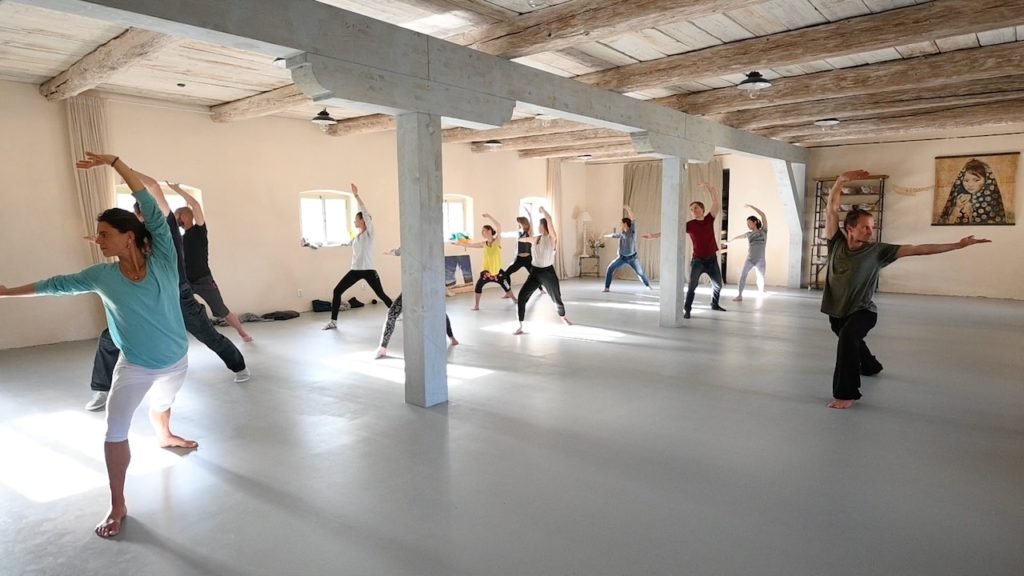APPLIED TECHNIQUES
MENU
Applied Techniques
The beneficial effect on health of the applied techniques is demonstrated by evidence-based scientific studies. Here are some examples:
BENEFICIAL EFFECT
Breathing exercises


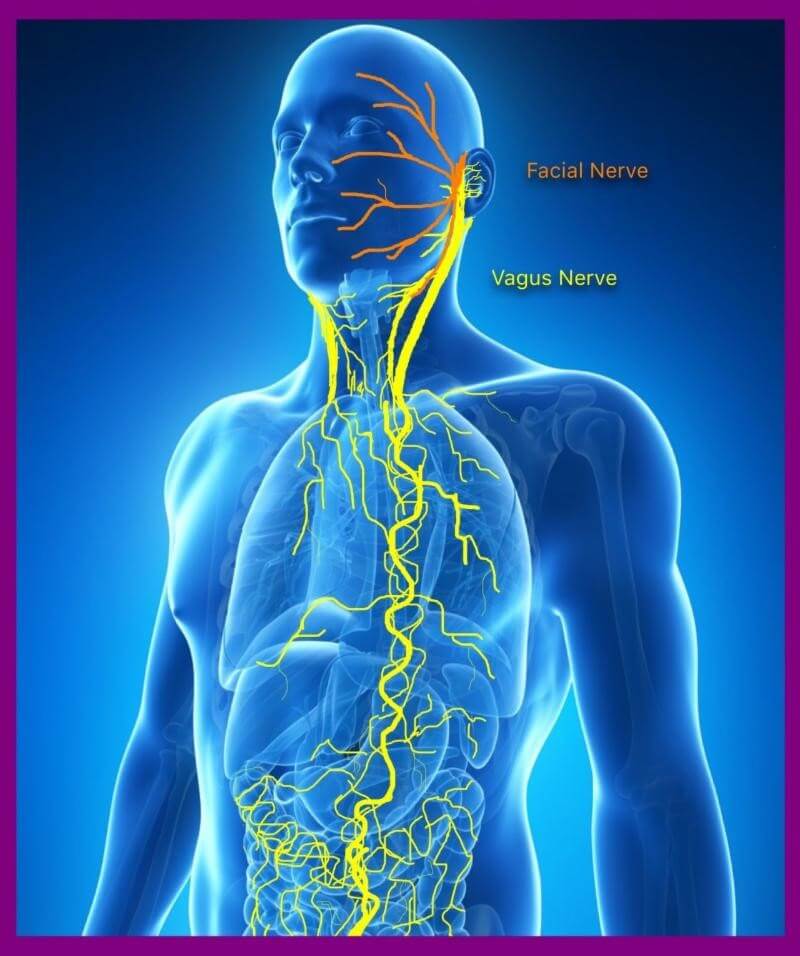

The beneficial effect of breathing exercises on the health is very complex. Breathing control is part of many other techniques including qi gong, taichi, yoga, freediving, cold baths (e.g. Wim Hof method) and others.
Breathing exercises have an impact on the stabilization of the postural musculoskeletal system, enhance oxygenation/perfusion of the inner organs and especially contribute to harmonization of the vegetative nervous system (VNS).
The Vegetative Nervous System (also called autonomic nervous system (ANS)) controls body’s involuntary functions and influences activity of internal organs. VNS has 2 components: SNS and PNS (sympathetic/parasympathetic nervous system):
- The Sympathetic Nervous System (SNS) supports action, mode of the “fight and flight” and is active in situations of stress and anxiety
- The Parasympathetic Nervous System (PNS) is prevalent in states of repose, digestion, sleep or sex and is important for restoration and relaxation
The Vagus nerve makes part of the PNS and interconnects inner organs with the brain. It also contributes in the immune function and anti-inflammatory activity in the body. Beside others, vagal nerve is stimulated through the stretch receptors in the lungs and by movements of diaphragm during deep breathing.
Vagus nerve theory within breathing techniques:
Breathing techniques stimulate baroreceptors within the vasculature, which influence the heart rate variability (HRV). Heart rate variability is relatied to well-functioning adaptability of the circulatory system to external stimuli and corresponds with better general health condition.
- Some studies presented that slow deep breathing 0,1 Hz (= 6/min) lowers trigger threshold for the HRV reflex causing slower heart rate, lower SNS and higher PNS activity (Sympathetic/Parasympathetic nervous system)
- Vagal nerve stimulation has an effect on the central autonomous network (prefrontal cortex, limbic system) which leads to decreased emotional over-reactivity, significant antidepressant and anxiolytic effect, and enhanced cognitive control and attentivity.
- Regular breathing exercises lead to structural modulation of the Central Nervous System (CNS) structures including the prefrontal cortex and limbic area, which are responsible for the emotional balance.
Breathing exercises also provide a direct inhibitory effect on the stress-hormone cortisol levels, which further impacts regulation of the hypothalamic-pituitary-adrenal axis (responsible e.g., for metabolism and immunomodulation). This explains better immune condition in practitioners of breathing exercises.
Further examples of the benefits of breathing techniques on a diversity of health disorders:
- GERD (gastro esophageal reflux disease): improvement through strengthening of the diaphragmatic muscles/ lower esophageal sphincter
- Asthma and COPD (Chronic obstructive pulmonary disease): improving of the pulmonary functions (strengthening of the muscles, better elasticity of the lung tissue), bronchodilation (probably due to enhanced CO2 blood levels in slow breathing), better physical fitness and subjective perception of the symptoms.
- Airways, sinusitis: “humming breathing” technique enhances nitrous oxide (NO) release from the paranasal cavities up to 15-fold compared to steady state, resulting in improved sinus ostial patency.
- Cardiovascular functions: general correction of chronic hypertension and other risk factors for a heart disease. Controlled slow deep diaphragmatic breathing (4-6/min) causes a significant decrease in HR (heart rate) and systolic blood pressure – mostly because of vagal modulation of the sympathetic activity.
- Internal organs: slow deep diaphragmatic breathing with activation of the abdominal muscles significantly improves perfusion, oxygenation and lymphatic drainage of internal organs, which is an important preventive factor of chronic disease and inflammation.
- Low back pain: significant releasing effect (strengthening of the deep stabilization system)
- Anxiety and depression: due to pronounced regulation of the stress axis, regular breathing exercises are reported to cause significant improvement of the stress-hormone related psychiatric disorders.
- Cognitive functions and attentivity: improvement due to parasympathetic predominance and better brain perfusion in the context of brain vessels vasodilation caused by higher CO2 levels. During breath holding pauses, EEG theta brain activity (responsible for alertness, attention, cognition, e.g.) is also increased.
Author of the review: Kristina Höschlová
https://pubmed.ncbi.nlm.nih.gov/32669763/
https://pubmed.ncbi.nlm.nih.gov/36292380/#affiliation-1
https://pubmed.ncbi.nlm.nih.gov/32233626/
https://pubmed.ncbi.nlm.nih.gov/33076360/
https://pubmed.ncbi.nlm.nih.gov/28714735/
https://pubmed.ncbi.nlm.nih.gov/22146488/
https://pubmed.ncbi.nlm.nih.gov/25035619/
https://pubmed.ncbi.nlm.nih.gov/29269971/
https://pubmed.ncbi.nlm.nih.gov/27632818/
https://pubmed.ncbi.nlm.nih.gov/32212422/
https://pubmed.ncbi.nlm.nih.gov/28779935/
https://pubmed.ncbi.nlm.nih.gov/22398346/
https://pubmed.ncbi.nlm.nih.gov/30584292/
https://pubmed.ncbi.nlm.nih.gov/31109966/
https://pubmed.ncbi.nlm.nih.gov/26364692/
https://pubmed.ncbi.nlm.nih.gov/18317923/
https://pubmed.ncbi.nlm.nih.gov/30356789/
https://pubmed.ncbi.nlm.nih.gov/12119224/
https://pubmed.ncbi.nlm.nih.gov/15305890/
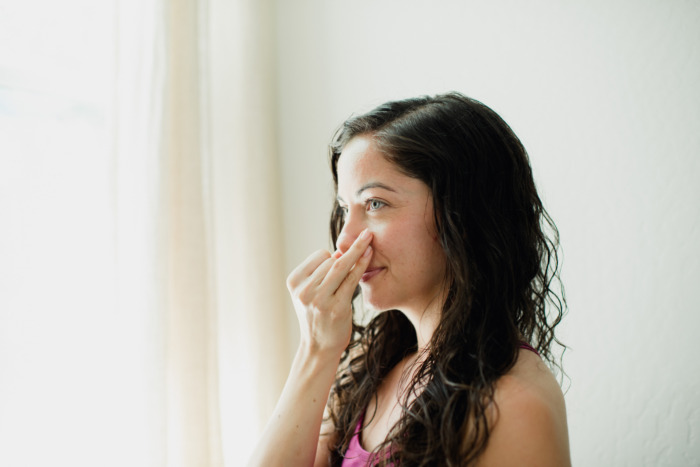
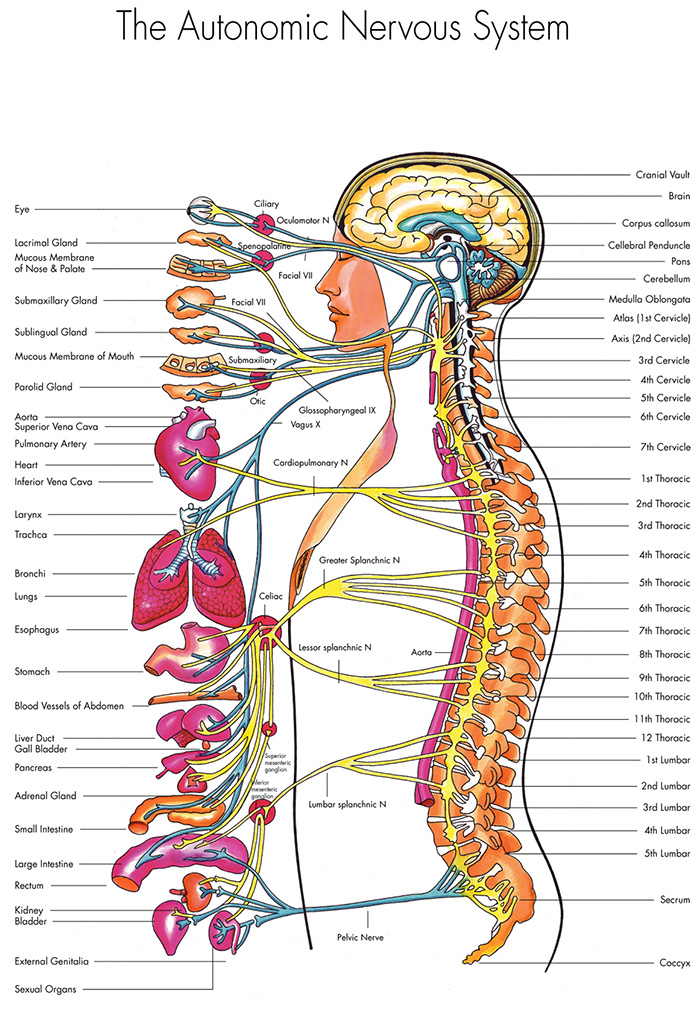
One of the commonly practiced breathing exercises is ALTERNATE NOSTRIL BREATHING
Alternate Nostril Breathing (Anuloma Viloma Pranayama in Sanskrit) originates in the Ayurvedic medicinal tradition.
During this exercise practitioner plugs one nostril using the other one for inhalation and/or exhalation. There are diverse forms of this technique: exclusive right nostril breathing, left nostril breathing or alternate breathing (left inhaling, right exhaling and vice versa).
Patency of each nostril also alternates during the day unconsciously because of transient congestion of the intranasal erectile tissue. It means, airflow is stronger in one nostril than in the other one and this condition changes periodically. It has been observed that nasal cycle correlates with the activity of the autonomic nervous system, physical activity, position of the body and with health condition of the individuals.
Other studies demonstrated that each nostril is related to its contra-lateral brain hemisphere as well as to one part of the autonomic nervous system.
These papers point out that using exclusive right nostril breathing stimulates left-brain functions such as verbal abilities, whereas left nostril breathing corresponds to the right-brain abilities, including spatial and emotional memory.
Exclusive right nostril breathing is probably more prone to the sympathetic activity (increased metabolism, oxygen consumption and blood pressure), whereas alternate nostril breathing demonstrated the parasympathetic effect (relaxation, stillness, decreased blood pressure) more significantly compared to the exclusive left nostril breathing.
These findings present an interesting view of a sophisticated interconnection of the regulatory mechanisms in human’s organism. It supports our knowledge that breathing exercises present an effective instrument to establish balance of the autonomic nervous system, to reduce stress, stimulate immune system and endorse general restorative mechanisms of the body.
Author of the review: Kristina Höschlová


TUMMO BREATHING
Tummo breathing, which translates as „inner fire,“ is an ancient breathing technique originally practiced by Tibetan Buddhist monks as a meditation practice that uses deep abdominal breathing together with visualization to increase a person’s inner heat and to achieve a deep meditative state.
Tummo consists of deep diaphragmatic breathing and prolonged retention of breath in different rhythms, complemented by visualization of a flame going up the spine.
Apart from the overall benefits attributed to breathing techniques in general, i.e. strengthening of the breathing muscles, massage of the inner organs, and increasing of the lung capacity, tummo breathing also causes remarkable change in body temperature and metabolism.
Tibetan monks, who have practiced tummo meditation for many years, present an increase in the temperature of their fingers and toes by 8°C after one hour of the practice. Also, monks wrapped in the wet sheets in freezing temperatures created enough heat to dry the sheets during the session.
Tummo breathing activates the sympathetic nervous system responsible for elevated physical activity and alertness and increases body temperature, blood circulation, and immunity processes. In the same way that exercising muscles strengthens them, voluntary activation of both regulatory nervous patterns (sympathetic and parasympathetic) increases overall resilience and resistance against adverse external stimuli.
Tummo breathing is usually related to or completed by cold water exposure and gave inspiration to the Wim Hof hardening methods.
Author of the review: Kristina Höschlová
PHYSICAL, MENTAL AND SPIRITUAL
Yoga Practice






Yoga is a system of physical, mental, and spiritual practices originating in ancient India about 3000 years ago with the aim to create union between body, mind, and spirit and to establish physical, mental, emotional and spiritual health.
Yoga practice includes 3 principal components:
– Asanas (physical exercises for strength and flexibility)
– Meditation (contemplative exercise)
– Pranayama (breathing exercises)
All of these components improve breathing patterns, thus contribute to the overall benefits of conscious breathing as mentioned above.
There is an extensive number of different evidence-based studies referring to the beneficial effects of yoga on health and these benefits are largely multifactorial.
Yoga exercise causes targeted perfusion and oxygenation of different organs and joints, enhances physical fitness, flexibility, self-perception, concentration and awareness and diminishes emotional reactivity, psychiatric disturbances or neuro-immuno-hormonal imbalance.
Some examples of the impact of YOGA on different health conditions:
- Depression: diminution of depressive symptoms in mild and moderate non-hospitalized depression, which is due to different mechanisms, such as: non-judgmental and observational awareness, acceptance of one’s limitations, enhanced self-esteem, alertness and calmness (parasympathetic activity).
- Overcoming chronic disease: significantly better outcome in yoga practitioners in the context of enhanced discipline, focused mind, calmness, stronger feeling of control about the ongoing illness, all of which lead to optimism and a positive outcome
- Pregnant women regularly exercising yoga from the 26th to 37th gestation week have demonstrated better birth outcomes compared to the non-practicing ones: decreased number of preterm labor, caesarian section or episiotomy, along with a better Apgar score in newborn
- Diabetes 2: better outcome and favorable control of blood pressure (BP), obesity, depression and anxiety, all of which frequently occur with diabetes disease.
- Cardiac system: positive effect on cardiac dysrhythmias due to the regulation/ harmonization of the autonomous nervous system (increased vagal tone, decreased sympathetic activity), control of atrial fibrillation (AF) and of high blood pressure (BP)
- Immune system: attenuation of the systemic inflammatory response, decrease in cortisol and inflammatory markers IL6 and CRP.
- Healthy habits: studies present that yoga practice improves stress management, weight loss in obese people, quitting smoking, and sleep quality.
Mechanism: How does YOGA improve health?
On the physical level, yoga practice strengthens muscles (especially of the body’s core), stretches tendons, and increases the range of the joints. The deep diaphragmatic rhythmic breathing helps to increase lung capacity, enhances lymphatic drainage of inner organs, and stimulates the vagus nerve. Vagal nerves make up part of the parasympathetic nervous system and contribute to the immune and anti-inflammatory response. It is estimated that higher vagal tonus supports immune response, recovery, and growth.
Yoga practice significantly increases practitioner’s awareness of their deep postural and stabilization system, which contributes to the prevention of injury and enhances the effectiveness of other physical exercises.
Awareness of balance, breathing patterns, and spatial positioning of the body helps to focus the mind, enhance concentration, and regulate subconscious mental processes. Yoga practitioners demonstrate attenuated emotional reactivity and increased self-regulation in response to unpleasant emotions and distress.
The impact of yoga is multifactorial. Since regular practice requires self-discipline, patience, and perseverance, these qualities also contribute to better health, quality of life, and inner satisfaction.
Author of the review: Kristina Höschlová
https://pubmed.ncbi.nlm.nih.gov/33024508/
https://pubmed.ncbi.nlm.nih.gov/15521557/
https://pubmed.ncbi.nlm.nih.gov/21665111/
https://pubmed.ncbi.nlm.nih.gov/24617167/
https://pubmed.ncbi.nlm.nih.gov/11218923/
https://pubmed.ncbi.nlm.nih.gov/32669769/
https://pubmed.ncbi.nlm.nih.gov/23008738/
https://pubmed.ncbi.nlm.nih.gov/31105261/
https://pubmed.ncbi.nlm.nih.gov/28301561/
https://pubmed.ncbi.nlm.nih.gov/18317923/
https://pubmed.ncbi.nlm.nih.gov/30356789/
https://www.nccih.nih.gov/health/providers/digest/yoga-for-health-science
COORDINATED BODY-POSTURE
Qi Gong practice
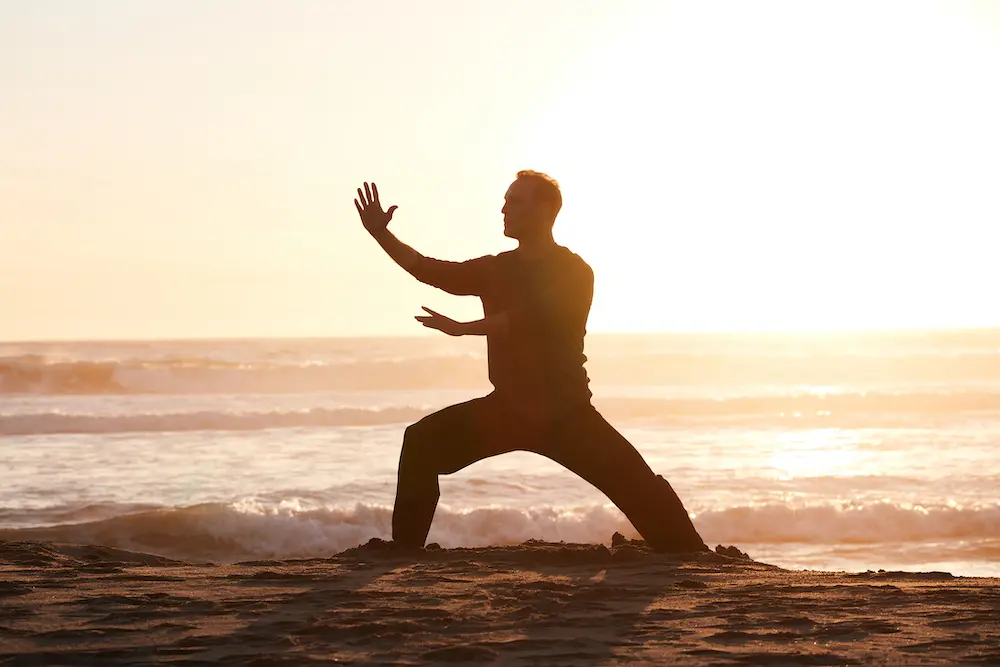


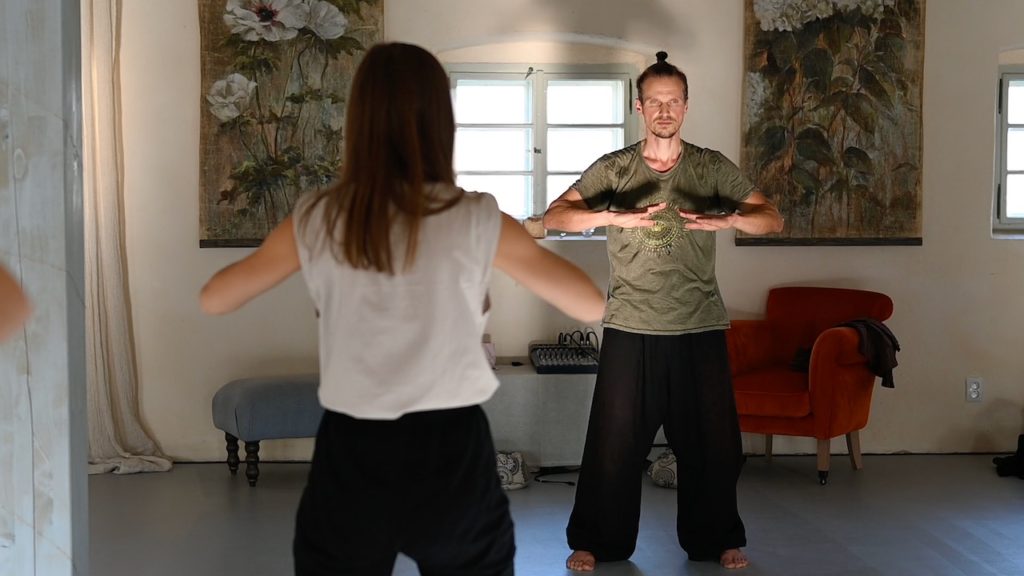

Qigong is a traditional self-healing, self-cultivation exercise originating in ancient China about 3-4000 years ago. Exercises based on traditional Chinese medicine are characterized by coordinated body posture and movements, deep breathing, and mental focus.
Qigong practice is considered to cultivate and enhance the inherent energetic essence of the human being (the “qi”) and activate naturally occurring physiological and psychological mechanisms of self-repair and health recovery.
The combination of self-awareness with self-correction of posture and movement of the body, the flow of breath, and stilling and focusing of the mind, is thought to reach the subconscious natural self-healing capacity.
Tai Chi, whose practice is often intertwined with Qigong, focuses more on fluid movements and balance and is also considered an energy-cultivating healing tool.
Some examples of the impact of Qigong on health:
- Cardiovascular system: Regular Qigong practice is reported to control blood pressure, heart rate, and heart rate variability positively, which suggests an effect on the balanced sympathetic and parasympathetic autonomic nervous system.
- Stress-related diseases: Qigong and Tai-Chi practices lower heart and breathing rate, restore homeostasis, and attenuate stress-related reactivity. In one study examining blood markers related to stress response, norepinephrine, epinephrine, and cortisol blood levels were significantly decreased in response to Qigong compared to a control group.
- Neurologic system:
– Qigong is reported to reduce falls and improve balance in older adults.
– Qigong may help in the treatment of Parkinsonism. A 2020 review of 7 studies (325 participants) suggested that qigong-based exercise helped improve movement, walking ability, and balance in people with Parkinson’s disease (more so in younger adults than older).
– Qigong practice promotes recovery of the central nervous system after injury. It improves the coordination of the hemispheres and helps rehabilitate lateral neurologic deficiencies.
- Immune system: Qigong improves immune function and reduces inflammation profiles as indicated by cytokine and T-lymphocyte blood levels.
- Mental health: Qigong and Tai-Chi involve anchoring attention to breath and other subconscious interoceptive body processes, which may lead to nonreactivity to aversive thoughts and impulses.
– Qigong reduces anxiety and depression and controls stress response. Qigong’s and Tai-Chi’s effects on emotion regulation could occur through changes in multiple prefrontal regions, the limbic system, and the striatum or in the expression of genes linked to inflammatory responses and stress-related pathways.(*)
- Respiratory system: Qigong as a complement to the primary treatment can improve lung function, quality of life, and physical activity in patients with COPD (Chronic Obstructive Pulmonary Disease).
- Low back pain: Qigong helps with the rehabilitation and treatment of lower back problems. Regular exercise enhances lumbar and abdominal strength, provides stable support for the lumbar vertebrae, and helps to maintain stability of the spinal column. The practice can improve lumbar lordosis and sacral inclination, thereby relieving chronic lower back pain. (**)
Qigong is an important complementary health-promoting movement practice.
It promotes musculoskeletal health – opens joints, lengthens tendons, and strengthens muscles, and provides a positive effect on mental health and overall well-being.
Author of the review: Kristina Höschlová
https://www.nccih.nih.gov/health/qigong-what-you-need-to-know
*https://pubmed.ncbi.nlm.nih.gov/31975898/
**https://pubmed.ncbi.nlm.nih.gov/31772593/
https://pmc.ncbi.nlm.nih.gov/articles/PMC3085832/
https://pubmed.ncbi.nlm.nih.gov/36348349/
https://pubmed.ncbi.nlm.nih.gov/31975898/
https://pubmed.ncbi.nlm.nih.gov/31221939/
https://pubmed.ncbi.nlm.nih.gov/18049436/
https://pubmed.ncbi.nlm.nih.gov/30428134/
https://pubmed.ncbi.nlm.nih.gov/15173671/
https://pubmed.ncbi.nlm.nih.gov/32471415/
https://pubmed.ncbi.nlm.nih.gov/31221939/
https://pubmed.ncbi.nlm.nih.gov/32629903/
https://pubmed.ncbi.nlm.nih.gov/24400778/
https://pubmed.ncbi.nlm.nih.gov/19880433/
EMOTIONS ARE REFLECTED IN THE BODY POSTURE
Movement techniques


Movement techniques in general
Emotions are reflected in the body posture.
When immersing in depressed thoughts we appear more with a hunched back than with an upright and open chest – rather corresponding to our happy thoughts.
Body language makes an inseparable part of the social-emotional interactions.
When in a happy mood, try to hunch your chest and droop your mouth corners. It is not easy, as similarly, it isn’t easy to open your chest and smile in a depressed mood either.
Negative thoughts cause negative emotions which lead to negative mood (hours) => negative behaviour (days) => negative character (months) => negative personality (years) => specific changes in somatic appearance.
This is how the emotions transcript in the body’s constitution.
However, we always have an option to change our mindset. Moreover, we can help it from the other end of the “chain”: focusing on the body posture and movement patterns.
Changing our body posture and movement patterns can trigger different thoughts => which lead to different emotions => different mood => different behaviour => different character => different personality.
Author of the review: Kristina Höschlová
Dance
Ever before, across all the diverse cultures of the World, dance wasn’t just a social-cultural element, but mostly an archetypal healing instrument.
Every culture in the World includes dance in their traditions. Dance makes up part of various ceremonies and rituals, from birth, wedding, and graduating from university to celebration of a harvest, successful hunt, or a funeral. Regular dance parties are still alive worldwide promoting an occasion to release tension, relax, generate positive emotions, and make social bonds.
Dancing has always been considered a means of positively affecting mental and physical well-being.
Dance is usually related to music and combines both, art and physical performance. Tunning into the music with structured movements allows practitioners to enhance their self-awareness.
Dance synchronizes subconscious mechanisms, such as proprioception, balance, and breathing patterns. Rhythmicity in movements stimulates subcortical brain processes, which is clearly evident in the treatment of Parkinsonism. Many studies suggest that dance improves gait, balance, and other motor functions in patients with Parkinson’s disease.
Numerous studies suggest the benefits of dance on health.
In general, regular dancing interventions generate significant changes in the physical, mental, and social skills and improve the quality of life of the individuals.
Dance proves positive effects on mental health (upregulation of serotonin), physical performance (changes in body composition, increased VO2 max), musculoskeletal functions (core stability, balance, flexibility), and cardiovascular system (decrease in stress-related biomarkers, improved physique).
Dance as a complementary healing technique shows benefits in the treatment of neurodegenerative diseases (dementia, parkinsonism), mental disorders (depression, anxiety, drug abuse), cancer patients (supporting and accelerating recovery), and people at risk of cardiovascular diseases (as a preventive tool).
Dance is a natural complementary healing tool, archetypally present in every culture. This is why it should be reconsidered as an innovative intervention strategy for patients with various comorbidities or underlying pathologies as well as for those in good health for prevention.
Author of the review: Kristina Höschlová
https://pubmed.ncbi.nlm.nih.gov/20019311/
https://pubmed.ncbi.nlm.nih.gov/34977404/
https://pubmed.ncbi.nlm.nih.gov/29270864/
https://www.ncbi.nlm.nih.gov/pmc/articles/PMC2780534/
https://pubmed.ncbi.nlm.nih.gov/16287635/
https://pubmed.ncbi.nlm.nih.gov/31894561/
https://pubmed.ncbi.nlm.nih.gov/34858507/
https://pubmed.ncbi.nlm.nih.gov/37287281/
https://pubmed.ncbi.nlm.nih.gov/29991355/
https://pubmed.ncbi.nlm.nih.gov/29428927/
https://pubmed.ncbi.nlm.nih.gov/27912941/
quieting the mind
Contemplative techniques
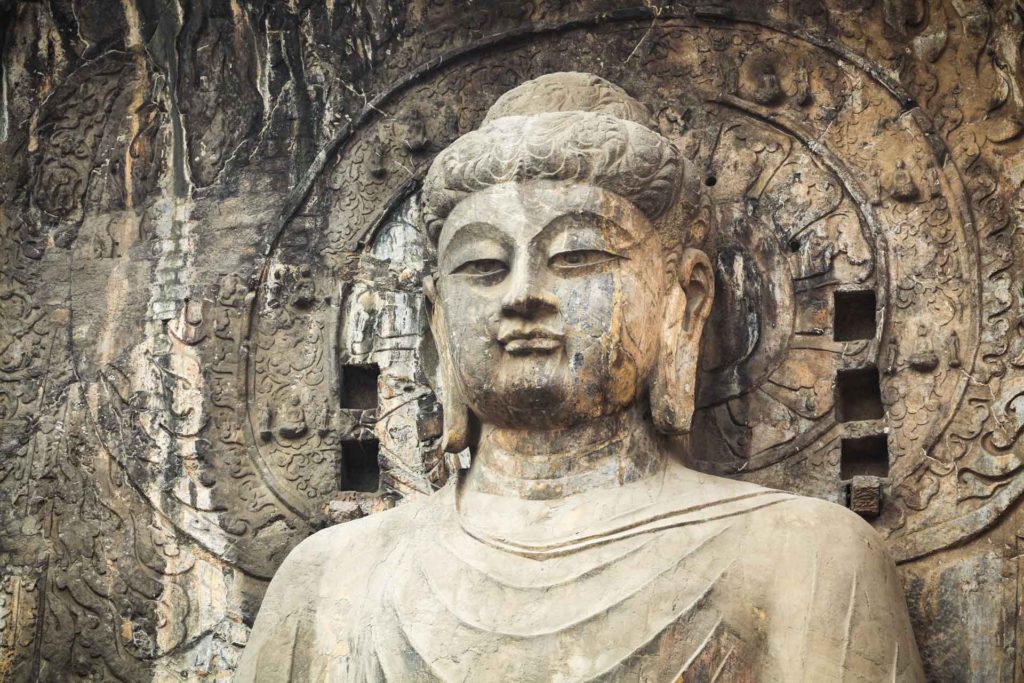



Contemplative practices develop capacity for quieting the mind and achieving an inner calm, leading to greater empathy, compassion and communication skills, improved attention, reduced stress and enhanced creativity. This results in improved health and quality of life (QoL).
Common forms include meditation, mindfulness, Tai Chi/Qigong, Yoga and prayer.
By creating a state of greater harmony within one’s body, contemplative practices can mitigate maladaptive biological (e.g. elevated blood pressure) and behavioral (e.g. substance abuse) responses, and lower the risk of some medical conditions (e.g. depression).
Contemplative practices have been particularly useful in the treatment of posttraumatic
stress disorder, in cardiovascular risk reduction, reducing health care provider burnout by increasing self-compassion, and possibly increasing longevity.
Mechanistically, contemplative practices have been noted to mediate health outcomes at a cellular level through its effects on gene expression. (Cited)
It is hypothesized that the effects of meditation are mediated by the endocrine system, including the hypothalamic–pituitary–adrenal axis, the hypothalamic–pituitary–thyroid axis, and the renin–angiotensin–aldosterone system. (Cited)
Mindfulness meditation — practiced widely for the reduction of stress and promotion of health — exerts beneficial effects on physical and mental health, and cognitive performance. Recent neuroimaging studies have begun to uncover the brain areas and networks that mediate these positive effects. (Cited)
Author of the review: Kristina Höschlová
https://pubmed.ncbi.nlm.nih.gov/30326604/
https://pubmed.ncbi.nlm.nih.gov/19735246/
https://pubmed.ncbi.nlm.nih.gov/19735248/
https://pubmed.ncbi.nlm.nih.gov/32037024/
https://pubmed.ncbi.nlm.nih.gov/30732832/
https://pubmed.ncbi.nlm.nih.gov/25783612/
https://pubmed.ncbi.nlm.nih.gov/11218923/
https://pubmed.ncbi.nlm.nih.gov/18317923/
Example of a contemplative practice
Loving-Kindness Meditation (Metta)
Loving-Kindness Meditation (Metta in Tibetan) is a contemplative method, which induces warm-heartedness, tolerance and kindness towards oneself and other living beings.
It consists of expressing wishes of happiness, peace, health and well-being. These wishes are directed first towards self and then extended to other people, from beloved ones to someone that might be perceived with negative emotions.
Example of the script of Metta meditation:
- May I be happy
- May I be peaceful
- May I be well
- May I live with ease
- May I find deep joy
- May I be free of pain
- May I be free from harm
- May I be free of suffering
- May I feel safe
Extended to => “May YOU be happy …. “ => “May HE/SHE/THEY be happy …”
Many studies investigated the behavioral and neurophysiological changes induced by this practice.
In sum, Metta meditation results in better stress reliance, enhanced tolerability and prosocial behavior, decreased anxiety and depression and decreased levels of stress-induced proinflammatory mediators.
E.g., in one study, 53 of 106 medical doctors have undergone training in Loving-Kindness-Meditation (LKM) during 8 weeks. Quality of mindfulness, empathy and communication skills were tested in both groups (LKM intervention and control group) before and after testing. The results displayed that group trained in LKM proved significantly increased empathy and communication skills towards patients compared to the control group and to the pre-test condition.
The states of loving-kindness have functional correlates in several brain structures, including e.g., amygdala, anterior insula, mesolimbic dopamine system, nucleus accumbens or some areas of the prefrontal and parietal cortex.
Loving-Kindness Meditation induces increased theta wave activity on EEG, which corelates with the states of relaxed wakefulness, memory formation and navigation. It also affects the autonomous nervous system resulting in slowed heart rate and is related to higher levels of hormone oxytocin, which is archetypally responsible for care-giving and nurturing of the offspring.
The peaceful, positive-minded and altruistic condition attained by this simple contemplative exercise of Metta meditation can positively affect spiritual, mental and physical well-being of the individuals.
Author of the review: Kristina Höschlová
https://pubmed.ncbi.nlm.nih.gov/30326604/
https://pubmed.ncbi.nlm.nih.gov/19735246/
https://pubmed.ncbi.nlm.nih.gov/19735248/
https://pubmed.ncbi.nlm.nih.gov/32037024/
https://pubmed.ncbi.nlm.nih.gov/30732832/
https://pubmed.ncbi.nlm.nih.gov/25783612/
https://pubmed.ncbi.nlm.nih.gov/11218923/
https://pubmed.ncbi.nlm.nih.gov/18317923/
STATE BEYOND ABSENCE OF DISEASE
Positive Health




Positive health describes a state beyond the mere absence of disease. Positive health can be operationalized by a combination of excellent status on biological, subjective, and functional measures. We can test the hypothesis that positive health predicts increased longevity (correcting for quality of life), decreased health costs, better mental health in aging, and better prognosis when illness strikes. The field of positive health has direct parallels to the field of positive psychology, parallels that suggest that a focus on health rather than illness will be cost saving and life-saving. (Cited)
Positive psychology is a rigorous academic field that encompasses character strengths, positive relationships, positive experiences, and positive institutions. It is the scientific study of what makes life most worth living – and maintains that what is good in life is as genuine as what is bad.
Virtues are core aspects of human excellence that allow us to survive and thrive. Researchers found six core virtues to be ubiquitous across cultures.
Positive psychology's 6 virtues
- Wisdom and Knowledge – Strengths of wisdom and knowledge are cognitive strengths related to the acquisition and use of information. Strengths comprised in this virtue are creativity, curiosity, open-mindedness, love of learning, and perspective.
- Humanity – Strengths of humanity involve caring interpersonal relationships with others, particularly in one-to-one relationships. Strengths comprised in this virtue are love, kindness, and social intelligence.
- Justice – Strengths of justice refer to the optimal relationship between the individual and the group or community, rather than the more one-to-one relationships in the humanity virtue. Strengths comprised in this virtue are teamwork, fairness, and leadership.
- Courage – Strengths of courage involve applying will and fortitude in overcoming internal or external resistance to accomplish goals. Strengths comprised in this virtue are bravery, perseverance, integrity, and enthusiasm.
- Temperance – Strengths of temperance protect us from excess. Strengths comprised in this virtue are forgiveness, humility, prudence, and self-control.
- Transcendence – Strengths of transcendence allow people to rise above their troubles and find meaning in the larger universe. Strengths of transcendence are appreciation of beauty and excellence, purpose, gratitude, optimism, and humor. (Cited)
‚
This is why activities of the Mehana Institute are complementary and embrace also art and beauty, hardening and resilience, and teamwork and creativity.
https://pubmed.ncbi.nlm.nih.gov/26060713/
https://posproject.org/character-strengths/
https://doi.org/10.1111/j.1464-0597.2008.00351.x
https://pubmed.ncbi.nlm.nih.gov/12883117/
https://pubmed.ncbi.nlm.nih.gov/7818221/
https://www.authentichappiness.sas.upenn.edu/learn/positivehealth
https://www.pursuit-of-happiness.org/science-of-happiness/
https://www.pursuit-of-happiness.org/history-of-happiness/martin-seligman-psychology/
https://www.pursuit-of-happiness.org/science-of-happiness/how-to-be-happy-quick-tips/
positive psychology in experiment (Comparative study):
Emotional style and susceptibility to the common cold
Sheldon Cohen, William J Doyle, Ronald B Turner, Cuneyt M Alper, David P Skoner
Objective: It has been hypothesized that people who typically report experiencing negative emotions are at greater risk for disease and those who typically report positive emotions are at less risk. We tested these hypotheses for host resistance to the common cold.
Methods: Three hundred thirty-four healthy volunteers aged 18 to 54 years were assessed for their tendency to experience positive emotions such as happy, pleased, and relaxed; and for negative emotions such as anxious, hostile, and depressed. Subsequently, they were given nasal drops containing one of two rhinoviruses and monitored in quarantine for the development of a common cold (illness in the presence of verified infection).
Results: For both viruses, increased positive emotional style (PES) was associated (in a dose-response manner) with lower risk of developing a cold. This relationship was maintained after controlling for prechallenge virus-specific antibody, virus-type, age, sex, education, race, body mass, and season (adjusted relative risk comparing lowest-to-highest tertile = 2.9). Negative emotional style (NES) was not associated with colds and the association of positive style and colds was independent of negative style. Although PES was associated with lower levels of endocrine hormones and better health practices, these differences could not account for different risks for illness. In separate analyses, NES was associated with reporting more unfounded (independent of objective markers of disease) symptoms, and PES with reporting fewer.
Conclusions: The tendency to experience positive emotions was associated with greater resistance to objectively verifiable colds. PES was also associated with reporting fewer unfounded symptoms and NES with reporting more.
Role of gratitude in preserving good health
Gratitude is a state of mind defined as “the quality of being thankful; readiness to show appreciation for and to return kindness”. Gratitude can also be considered an emotion, a trait, or a virtue.
Multiple studies showed that the feeling of gratitude is associated with better health-related quality of life.
“Positive psychological attributes, such as gratitude, play a critical role in improving cardiovascular health outcomes. Gratitude not only enhances psychological, and physical well-being but may also alter biomarkers of risk for cardiovascular disease.” (Cousin et al., The Journal of Positive Psychology 2021).
Quality of gratitude has been observed e.g., in relation to recovery after acute coronary syndrome. Patients who endured an acute coronary event show better recovery, better endothelial parameters, and better adherence to healthy-preventive behavioral recommendations when revealing grateful emotions.
One study demonstrates that when gratefulness is associated with support-giving behavior, this association leads to regulation of reactivity to threat and reduction of proinflammatory cytokines, such as TNF-alfa and IL-6 (associated with the development of cancer).
The simplest way, how to implement this highly beneficial quality into daily life, is to manifest thankfulness every evening towards 3 different events of the day. Once this practice becomes a habit, improvement in overall well-being and good health condition can possibly be observed.
Author of the review: Kristina Höschlová
https://pubmed.ncbi.nlm.nih.gov/34780238/
https://pubmed.ncbi.nlm.nih.gov/27796252/
https://pubmed.ncbi.nlm.nih.gov/33932527/
https://pubmed.ncbi.nlm.nih.gov/30265078/
https://pubmed.ncbi.nlm.nih.gov/20451313/
https://www.tandfonline.com/doi/abs/10.1080/17439760.2020.1716054
https://positivepsychology.com/gratitude-appreciation/
WIDE VARIETY OF HEALTH BENEFITS
Hardening


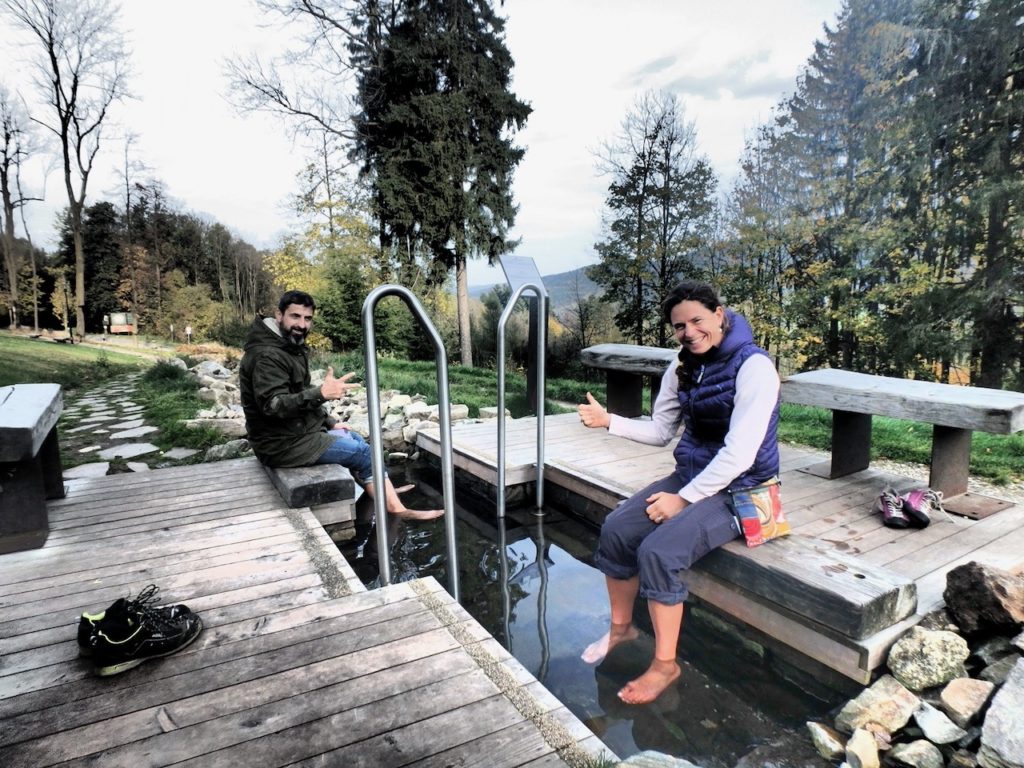
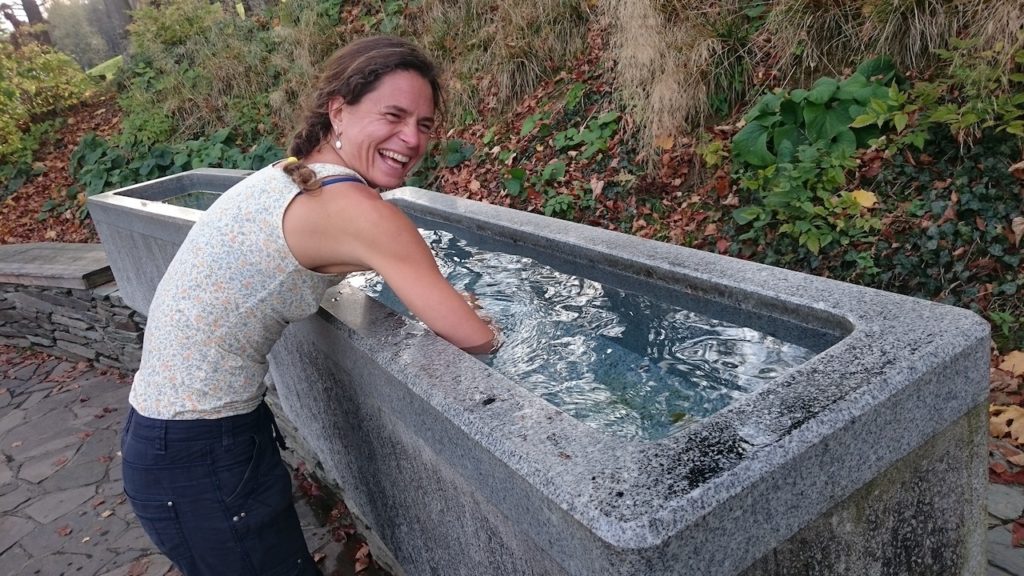
Cold Water Swimming
Cold water swimming describes swimming outdoors (lake, river, sea, swimming pool, etc.) mainly during the winter period or in the colder regions.
Several studies have suggested that cold water swimming has a wide variety of health benefits, including positive changes in hematological and endocrine function, fewer upper respiratory tract infections, amelioration of mood disorders and improved general well-being.
E.g., one study reported a 40% decrease in the upper respiratory infectious diseases in winter swimmers compared to a control group.
Considering the cardiovascular risk factors, a positive impact on lipid profile and on the blood pressure has been described.
Cold water swimming also contributes to treatment of depressive mood disorders, probably due to enhanced levels of norepinephrine and endorphin.
Huttunen et al. demonstrated that tension, fatigue, memory and negative mood in the swimmers significantly decreased with the duration of the swimming period. Also, all swimmers who suffered from rheumatism, fibromyalgia, or asthma, reported that winter swimming had relieved pains.
Winter swimming may increase body tolerance to stressors and achieve body hardening. When practiced by individuals who are in good general health adopting a regular, graded and adaptive mode, winter swimming seems to confer cardiovascular, and other health benefits. On the other hand, unaccustomed individuals are at risk of death either from the initial neurogenic cold-shock response, or from progressive decrease of swimming efficiency or from hypothermia. (Cited)
Author of the review: Kristina Höschlová
Kneipp hydrotherapy
Sebastian Kneipp was a German Catholic priest and one of the forefathers of the naturopathic medicine movement in the 19th century.
Kneipp hydrotherapy is a complementary non-pharmacological and non-invasive approach and is mainly known for its form of alternate cold and warm, upper or lower limbs water affusions. It has an active effect on the vessels causing alternative vasoconstriction and vasodilation. Modulation of adrenergic hormones production has also been demonstrated in association with this therapeutic method.
Immunologically, hydrotherapy increases serum concentrations of the immunomodulators. The use of alternate cold and warm back affusions has been found to have positive effects on the immunoregulation.
Serial cold and warm water stimulation hydrotherapy for osteoarthritis of the hip or knee joint showed improvement of restricted joint mobility, along with significant pain reduction and increase in quality of life over a period of up to three months.
Kneipp hydrotherapy applied over 6 weeks to the upper extremities in children aged 3-6 years reduced incidence of the lower respiratory tract infections.
Author of the review: Kristina Höschlová
heart activity harmonizing effect
Music therapy
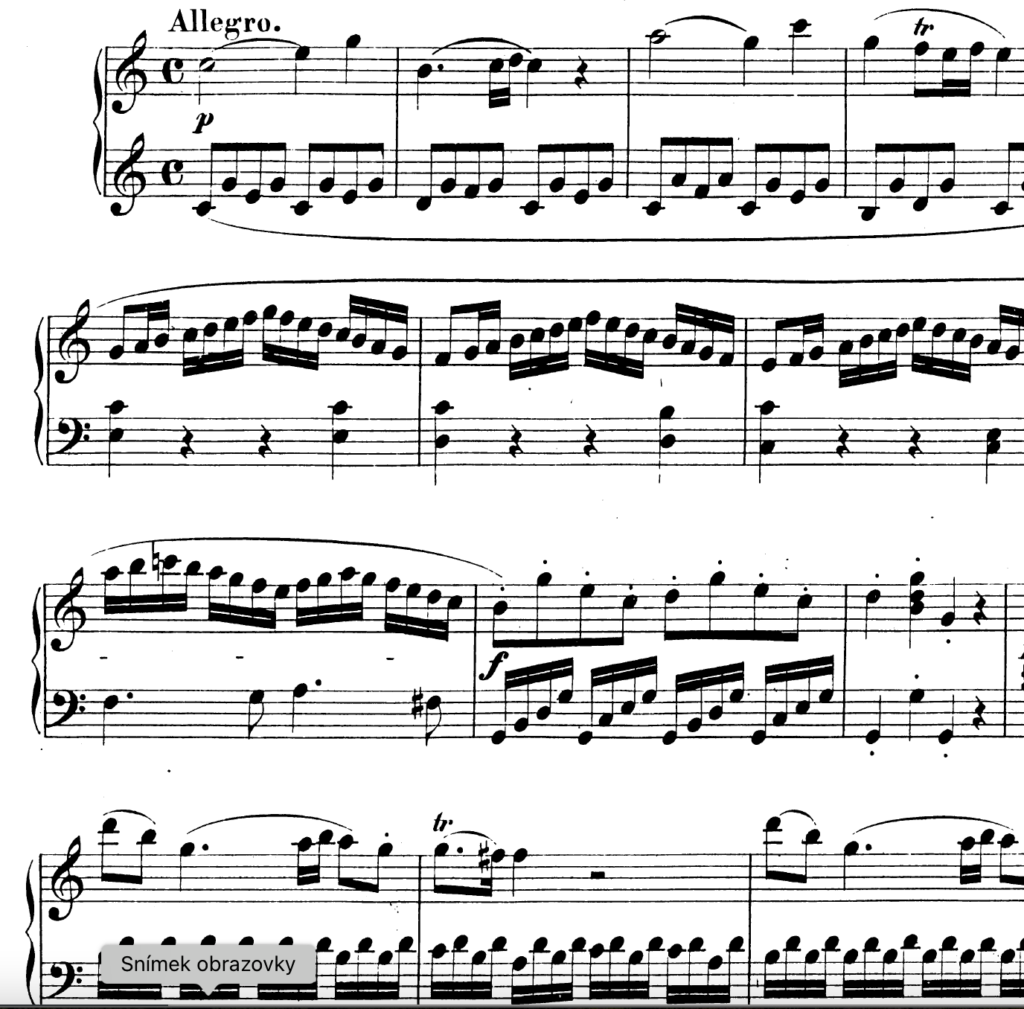




Music is an inseparable part of human’s cultures all over the world.
E.g., classical music (mainly from the baroque and classical epoch) is known to have an anti-anxious, relaxing, pain-relieving and heart activity harmonizing effect. Music therapy is used for psychical mood disorders, autism, chronic pain, epilepsy and diverse stress-related pathological conditions. Playing vocal and orchestral classical music in the ICU has resulted in a decrease in cortisol levels.
Music therapy proves its benefits also in different neurological disorders, such as epilepsy, autism, dementia, parkinsonism and other neurodegenerative diseases.
Studies report that musical rhythm in Parkinson’s disease treatment can improve gait (speed, frequency, and step length), limbs coordination, postural control, and balance. Moreover, music is considered as strong stimuli from the emotional point of view, playing an important role in the activation of the limbic system.
One study reports about 18 children treated for epilepsy, exposed daily to 8 minutes listening of the Mozart Concerto for 2 pianos D major (K.448) before sleep.
During this time, remarkable decrease in the epileptogenic activity (EEG) has been observed: 1st month by 53%, 2nd month by 64% and 6th month by 72%.
Another study tested EEG in 68 children – before and after listening to the Mozart’s K.448 (Concerto for 2 pianos D major) and K.545 (Sonata for piano C major). This resulted in decrease in the epileptiform activity by 33% (K.558) and 38% (K.545) respectively.
There are several hypotheses trying to explain the “Mozart effect”, such as benefits of the repeated melody line or unpredictable rhythm changes. It is assumed that the frequency of the tones, melody line and rhythm affect the autonomous nervous system as well as the limbic system, thereby leading to the overall restorative and relaxing conditions.
In other studies, some particular frequencies have been investigated, including the “Love frequency” of 528 Hz (C4), the “Healing frequency” of 432 Hz (A4) or the actual tunning frequency 440 Hz (A4).
Studies report diverse positive effects such as increased cell viability, increased serotonin/endorphins release, positive cognitive development, serenity and enhanced creativity.
In the context of yoga, meditation and pranayama (breathing techniques), beneficial effect of OM chanting has been inspected. The relaxing, anti-anxiety and restorative effects are explained by possible vagal nerve stimulation through the intracranial vibrations as well as harmonization of the limbic system. OM chanting might have similar benefits to humming breathing technique, which is reported to enhance the nitrous oxide (NO) release 15-fold compared to steady state, resulting in favorable effect on sinus ostial patency.
Author of the review: Kristina Höschlová
https://pubmed.ncbi.nlm.nih.gov/25789207/
https://pubmed.ncbi.nlm.nih.gov/20019311/
https://pubmed.ncbi.nlm.nih.gov/20013543/
https://pubmed.ncbi.nlm.nih.gov/19583647/
https://pubmed.ncbi.nlm.nih.gov/21843204/
https://pubmed.ncbi.nlm.nih.gov/21062776/
https://pubmed.ncbi.nlm.nih.gov/34256336/
https://pubmed.ncbi.nlm.nih.gov/9660010/
https://pubmed.ncbi.nlm.nih.gov/21689988/
https://pubmed.ncbi.nlm.nih.gov/26339666/
https://pubmed.ncbi.nlm.nih.gov/23540417/
https://pubmed.ncbi.nlm.nih.gov/26379619/
https://pubmed.ncbi.nlm.nih.gov/36382320/
https://pubmed.ncbi.nlm.nih.gov/37510618/
https://pubmed.ncbi.nlm.nih.gov/25725914/
https://pubmed.ncbi.nlm.nih.gov/10412284/
https://pubmed.ncbi.nlm.nih.gov/16597779/
https://pubmed.ncbi.nlm.nih.gov/16597776/
https://pubmed.ncbi.nlm.nih.gov/31671873/
https://pubmed.ncbi.nlm.nih.gov/31031095/
https://pubmed.ncbi.nlm.nih.gov/30414050/
https://pubmed.ncbi.nlm.nih.gov/25035619/
https://pubmed.ncbi.nlm.nih.gov/21654968/
https://pubmed.ncbi.nlm.nih.gov/29752573/
SINGING
Since time immemorial, singing and dance have been a part of every culture.
Both embrace the artistic experience and physical exercise and so it is therefore not surprising that dance and music have long been regarded as contributing to good health.
Salutary effects of singing have been described in respect of different organ systems; especially in the respiratory, cardiovascular, neurologic and immune system.
In the respiratory system, singing improves muscle strength, mucosal immunity and patency of the sinuses. In COPD (Chronic obstructive pulmonary disease) patients who sing for example, there is improvement in overall lung functions.
Singing has been reported to improve cardiovascular function, which is reflected, for example in better peripheral endothelial elasticity. The benefits of singing in patients with cardiovascular disease are attributed to autonomic nervous system regulation with parasympathetic predominance due to increased vagal nerve activity.
During singing, diaphragmatic work and increased intrathoracic pressure stimulate the vagal nerve, which results in autonomic nervous system regulation with parasympathetic predominance.
Increased air flow also improves the passage of phlegm in the airways and reinforces mucosal immunity. Singers have been reported to have better recovery from the COVID.
Singing makes up part of the complementary treatment in neurologic diseases, especially in Parkinson’s disease. Singing seems to have an impact on basal ganglia function. Training in mental singing while walking improves gait disturbances.
Singing leads to an improvement in vocalization, speech and intensity of voice. This has been demonstrated not only in patients suffering from neurodegenerative diseases, but also in those with quadriplegia and other neurologic impairments.
Regular singing is related to a positive increase in quality of life, good mood and psychosocial wellbeing. Also, increased levels of immunoglobulin A, oxytocin and endorphins have been reported in people who intensively practiced singing.
Another possible mechanism for how singing impacts the HPA (hypothalamic-pituitary-adrenal) axis may be the stimulation of central nervous structures due to intracranial vibrations caused by produced tones. The same mechanism is considered to underly improvement of function of the thyroid gland and the intrathoracic lymphatic structures.
Singing seems also to modulate qualitative neurologic functions. One experiment has shown that singing enhances the “production effect”, which means that items read aloud are better memorized than if read silently. It has been found out that items being sung aloud revealed overall best recognition compared to those being read – either aloud or silently.
Nowadays, singing is mainly used in the treatment of Parkinson’s disease and in the rehabilitation of chronic lung diseases. However, as singing causes effects similar to those of breathing techniques, both having an impact on the cardiorespiratory and neurohumoral system, it should be considered as an excellent adjunctive therapeutic tool in different medical conditions including psychiatric mood disorders.
Author of the review: Kristina Höschlová
https://pubmed.ncbi.nlm.nih.gov/35924212/
https://pubmed.ncbi.nlm.nih.gov/18756088/
https://pubmed.ncbi.nlm.nih.gov/23103430/
https://pubmed.ncbi.nlm.nih.gov/11811096/
https://pubmed.ncbi.nlm.nih.gov/34770129/
https://pubmed.ncbi.nlm.nih.gov/29137545/
https://pubmed.ncbi.nlm.nih.gov/36358382/
https://pubmed.ncbi.nlm.nih.gov/36407671/
https://pubmed.ncbi.nlm.nih.gov/36674142/
https://pubmed.ncbi.nlm.nih.gov/26987751/
https://pubmed.ncbi.nlm.nih.gov/35570643/
https://pubmed.ncbi.nlm.nih.gov/19436683/
HEALING TOUCH
Manual Medicine and Healing Touch




The healing power of human touch has been part of every medicinal tradition since their beginnings.
In the Western medicine tradition, manual therapy dates back to Hippocrates and Galen and reappeared in the 19th century with the onset of chiropractic and osteopathic medicine.
Manual medicine, the use of hands in healing, is founded on the concept that the body possesses self-healing mechanisms and that structure and function are interrelated. The goal is to promote optimal structural alignment to encourage self-healing processes.
The hands-on medical approach includes manipulation and mobilization of the joints, traction, and soft-tissue techniques, such as massage.
Manual correction of the body’s alignment, as well as compression or tactile stimulation of specific areas, trigger a chain of impulses that travel to the central nervous system and are supposed to cause recalibration and repair of the malfunctioning body areas.
In the visceral-somatic physiotherapeutic approach, the therapist manually corrects specific articulations and soft-tissue areas in order to stimulate the self-repairing mechanisms of the corresponding internal organ.
The healing power of human hands does not include only manual techniques:
-Touch by itself is highly beneficial for mental, emotional, and physical health.
Human touch remarkably contributes to the control of stress response and inhibits the manifestation of inflammation, risk of infection, pain, and depression.
– A gentle touch is an effective first-aid measure in case of acute pain.
Gate control theory of pain explains that gentle touch can override and reduce painful sensations because the pain-leading neurons are multimodal and respond to both – nociceptive (pain) and tactile (touch) inputs. When the pain-leading pathway is activated, tactile transmission can take its place, which results in pain relief.
Affectionate parental touch promotes better prosperity, growth, and reduced stress patterns in their offspring. Numerous studies have focused on the early development of infants regarding exposure to human touch. Field et al. demonstrated that a 15-minute massage of preterm infants applied 3 times a day for 10 days resulted in up to 47% greater weight gain and 6 days earlier discharge from hospital than in non-massaged infants.
Tactile receptors stimulate the vagal nerve, which contributes to the decrease of stress hormones and promotes immune and growth mechanisms in the body.
Paradoxically, human contact can reduce the risk of infections, as presented by Cohen et al. In their study, people who were more frequently hugged 14 days prior to a cold virus exposure consequently demonstrated a lower risk of infection and milder symptoms. Also, during the pandemic COVID 19, reduced opportunity for human touch was linked with an enhanced risk for inflammation (Thomas & Kim, 2021), which demonstrates the adverse effects of some anti-epidemic measures.
Human touch is an essential part of the complementary healing techniques available to anybody at any time. Even if a hug, kiss, pat on the back, or a hand-holding from close ones is not available, massage or self-massage can be of benefit.
Author of the review: Kristina Höschlová
Benefits of massage therapy
https://www.ncbi.nlm.nih.gov/pmc/articles/PMC2844909/
https://pubmed.ncbi.nlm.nih.gov/27502797/
https://pubmed.ncbi.nlm.nih.gov/37878283/
https://pubmed.ncbi.nlm.nih.gov/27258432/
https://pubmed.ncbi.nlm.nih.gov/38633004/
https://pubmed.ncbi.nlm.nih.gov/17709060/
https://pubmed.ncbi.nlm.nih.gov/18478478/
https://pubmed.ncbi.nlm.nih.gov/8477405/
https://pubmed.ncbi.nlm.nih.gov/12017502/
Benefits of Human Touch
https://www.ncbi.nlm.nih.gov/pmc/articles/PMC4323947/
https://www.ncbi.nlm.nih.gov/pmc/articles/PMC3988987/
https://pubmed.ncbi.nlm.nih.gov/38589702/
https://pubmed.ncbi.nlm.nih.gov/32845008/
https://pubmed.ncbi.nlm.nih.gov/33329093/
https://pubmed.ncbi.nlm.nih.gov/37252874/
https://pubmed.ncbi.nlm.nih.gov/27225036/
https://pubmed.ncbi.nlm.nih.gov/31358458/
https://pubmed.ncbi.nlm.nih.gov/32837856/
https://pubmed.ncbi.nlm.nih.gov/35757667/
https://pubmed.ncbi.nlm.nih.gov/16262207/
Manual medicine
https://www.sciencedirect.com/science/article/abs/pii/B9780323625395000163
https://www.sciencedirect.com/science/article/abs/pii/B9780323722162000144
Harmonization of the energy channels
Acupressure
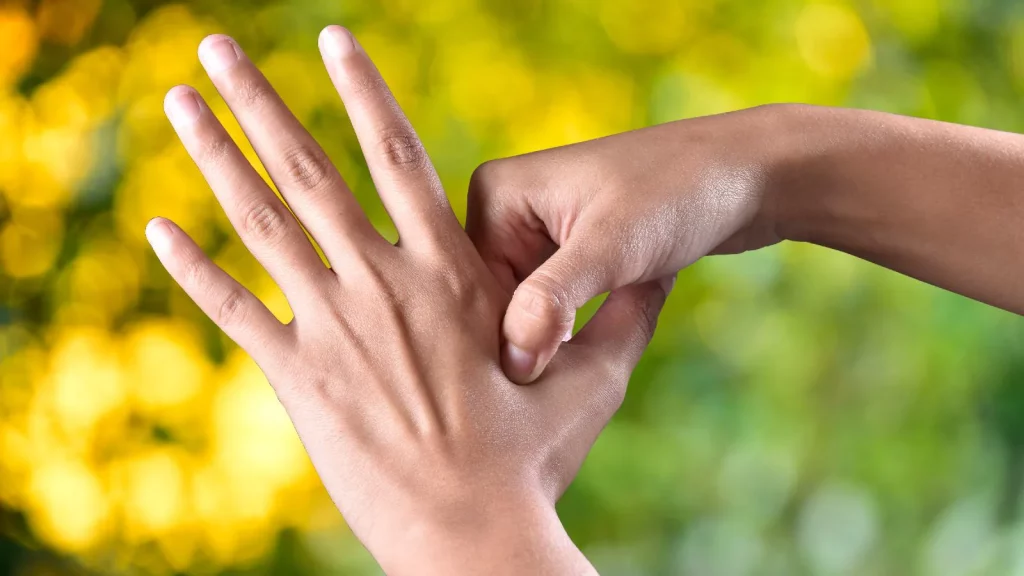
Acupressure is an ancient healing technique originating in China approximately 4000 years ago.
It is based on the philosophy of the traditional Chinese medicine that a life-force or energy (known as Qi /”Chi”) is constantly flowing through the body along channels (Meridians). It is believed that when these channels become blocked or there’s an imbalance, fatigue or illness may occur in corresponding organs.
Acupressure consists of pressing specific points in an attempt to help the free flow of energy in the channel(s). Acupressure is similar to acupuncture, but the person uses their fingers instead of needles to work the point.
One can consider the relationship between acupoints, marma points (used within ayurvedic medicine) and the reflex- and trigger-points known in modern physiotherapy.
Acupressure can also be applied as a self-treatment complementary technique and is mostly used to manage acute pain, headache, lower back pain, nausea, insomnia, constipation and anxiety.
In 1950, neurosurgeon Dr.Paul Nogier laid the foundations of the Auricular Acupressure hypothesizing that specific parts of the body correspond to specific points of the ear.
Mechanisms of acupressure are multifactorial. The relaxing effect, similar to the effect of simple human touch, is based upon the neuro-humoral stimulation of the hypothalamic – pituitary – adrenocortical axis. Acupressure induces a neuro-humoral response which ultimately causes the release of endorphins in the central nervous system and modulates cortisol levels resulting in relaxation and sensation of well-being.
The analgesic effect is explained by the Melzack-Wall Gate Theory, which states that the impulse of touch is transferred to the CNS four times faster as the pain stimulus, thereby drowning out the perception of pain.
Acupressure also acts locally, enhancing the blood flow and resolving the tissue adhesion in area of application.
Furthermore, if applied in the exact points regarding the organ meridians, acupressure is supposed to cause a specific symptom focused effect such as e.g., anti-nausea, anti-constipation or the release of lower back pain.
Author of the review: Kristina Höschlová
https://pubmed.ncbi.nlm.nih.gov/23415783/
https://pubmed.ncbi.nlm.nih.gov/25175554/
https://pubmed.ncbi.nlm.nih.gov/23130943/
https://pubmed.ncbi.nlm.nih.gov/33708260/
https://pubmed.ncbi.nlm.nih.gov/32950391/
https://pubmed.ncbi.nlm.nih.gov/35085025/
https://pubmed.ncbi.nlm.nih.gov/30105749/
https://pubmed.ncbi.nlm.nih.gov/34766929/
https://pubmed.ncbi.nlm.nih.gov/32782111/
The healing power of nature
Herbal Medicine

Since time immemorial, plants have been used for healing and herbal medicine has made up part of every medicinal tradition all over the world. However, with the boom of the pharmaceutical industry in the last century, benefits of herbal medicine have been eclipsed with the new beliefs in the efficacy of synthetic products.
Although modern drugs are mostly derived from substances originating from plants, their dosage is more precise and controllable compared to herbal remedies.
This was the main argument to support the development of synthetic medications, as the determination of the effective dosage together with the elimination of undesired effects was regarded as more achievable.
Mechanisms underlying treatment with herbal medicine are complex and go beyond the mere understanding of chemical composition of the plant. Plants are living organisms subordinated to the same rules of Life on Earth as human beings. Like all living organisms, plants use deoxyribonucleic acid (DNA) as their genetic material and emanate electrochemical potentials, which can contribute to their interactions with other living forms.
Over the course of history, humanity has tended to change. Nowadays, the values, beliefs and priorities of mankind has been subject to transformation. Many people are tending more to nature and natural products and are reluctant to use synthetic ones. This current trend can also be observed in medicine.
It seems therefore, there is still an unexplored field of the healing interaction between plants and humans, which invites more precise scientific investigation. It is very possible that the benefit of herbal medicine will be reappraised in coming times.
Author of the review: Kristina Höschlová
Representatives of the herbal medicine
Lavender


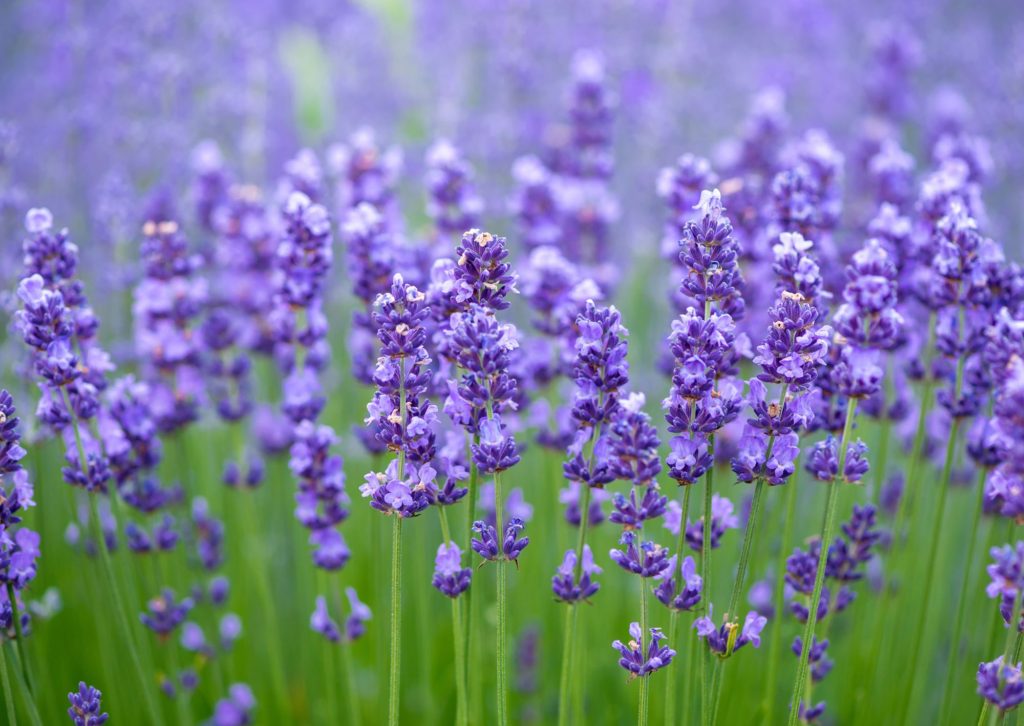

Lavender is a beautiful, fragrant plant from the Lamiacae family, with flowers in the shades of blue and violet. It is native to the Mediterranean area, nowadays spread across the world, mainly in the Euro-Asian and African continent. The name comes from the Latin “lavare” = to wash, a reference to its former use for washing clothes.
It includes more than 30 species; however, the various lavenders share similar ethnobotanical properties and major chemical constituents.
Lavender is well known for its pleasant scent, and its fragrant essential oils are used in perfumes and cosmetics. The buds are also used as spices for culinary purposes, while the lavender honey is also highly valued. Moreover, it is recognised as an important component in herbalism and natural medicine.
Lavender contains linalool, tannins, camphor, terpenes, coumarin and other chemical substances, which contribute to its diverse curative properties.
Lavender is mostly known as an antioxidant, anti-spasmodic, pain-relieving, anti-inflammatory, antibacterial, wound-healing, anxiolytic and relaxing agent.
Numerous medical studies investigate the above-mentioned effects and recommend the use of this plant as complementary medicine with minimal side effects.
Lavender is mostly administered as aromatherapy in a vaporiser, or through a face mask, where several drops of lavender essential oil are added to the oxygen in hospitalised patients. It can also be ingested as a pure herbal tea, or even in the form of oral capsules containing lavender essential oil.
Lavender has been medically tested with regard to its anxiolytic and stress-relieving effects, and in treatment of sleeping disorders. For example, oral ingestion of the lavender oil preparation (Silexan, 80 mg) proved the same anxiolytic effect as the synthetic medication Lorazepam (0,5 mg). As for the anti-anxiety effects, lavender aromatherapy administered in the intensive care units resulted in significant decrease of the surgery related stress, and the demand for painkillers in patients, with a positive effect on mood.
The mechanisms of action are multiple. It is understood that lavender oil acts through two principal pathways. One of them is via the olfactory (smelling) system having a direct impact on the pituitary gland, where the release of corticotrophin results in lowering of the cortisol (stress-hormone) levels, while the other entails diffusion through the blood which subsequently alters neurotransmission in the brain, especially in higher concentrations.
However, in one experiment on mice, the olfactory pathway was blocked by induction of anosmia (blocked smell) with the zinc derivates. Lavender was administered by aromatherapy and if concentrated above 2,5%, subjects proved the same decrease in anxiety as the smelling ones. It suggests another pathway of action – diffusion in the blood and alteration of neurotransmission in the central nervous system.
Lavender inhalation also relieves pain. One study followed over 1600 woman during childbirth, where half of the women were provided with lavender inhalation while the other half was not. Comparing their experience of pain during labour on a numeric scale from 0 to 10, the average pain score of women inhaling lavender was 5.4, while the average of the control group was 7,2. Another study demonstrated decrease in migraine headache by 3,6 points in lavender-tested group compared to 1,6 points in the control group. The addition of lavender to a massage oil during an acupressure procedure resulted in higher pain relieve, especially in the lumbar and neck area.
Furthermore, lavender has important effects on wound-healing, especially in burns. Direct application of diluted oil in the wound leads to faster healing. Lavender oil also noticeably inhibits growth of the methicillin resistant Staphylococcus aureus (MRSA), bacterial infectious agent which significantly interferes with wound healing.
In obstetrics, lavender essential oil sitz baths caused important pain relief and proved better wound healing after episiotomy.
Lavender aromatherapy has an important effect on insomnia (sleep disorders). During the 15-minutes lasting inhalation, the electric brain signals (EEG) of patients showed increase in alpha and theta activity, which correspond to the processes of relaxation and memory formation, respectively.
Lavender essential oil might occasionally cause undesired side effects as e.g., skin irritation or an allergic reaction. Also, constipation and headache have been reported.
Lavender is a beautiful, undemanding plant, rich in health beneficial properties, thus affecting positively psychological and physical well-being, used either as an essential oil in aromatherapy (several drops in a vaporiser), or in preparation of ointments, massage oils, and other local applications (1-5% dilution in a carrying oil). It is always recommended to test the skin reaction before application.
Lavender buds can be employed as a condiment for desserts as well in salty dishes, or as a pure herbal infusion (one entire spike per litter of boiling water).
Author of the review: Kristina Höschlová
https://www.sciencedirect.com/science/article/pii/S2221169115001033
https://pubmed.ncbi.nlm.nih.gov/35617792/
https://pubmed.ncbi.nlm.nih.gov/31671873/
https://www.ncbi.nlm.nih.gov/pmc/articles/PMC5039451/pdf/brainsci-06-00022.pdf
https://pubmed.ncbi.nlm.nih.gov/21854199/
https://pubmed.ncbi.nlm.nih.gov/33224252/
https://pubmed.ncbi.nlm.nih.gov/12112282/
https://pubmed.ncbi.nlm.nih.gov/19249919/
https://pubmed.ncbi.nlm.nih.gov/22517298/
https://pubmed.ncbi.nlm.nih.gov/28579958/
Do you like to learn more about medicinal herbs? Subscribe to our monthly newsletter and you will get an overview of one medicinal herb every month. Moreover, you will enjoy our “Topic of the month”, some interesting information from complementary medicine, inspiration for reflection and action and one Mehana teaching video every 2 months.
The healing power of nature
Aromatherapy
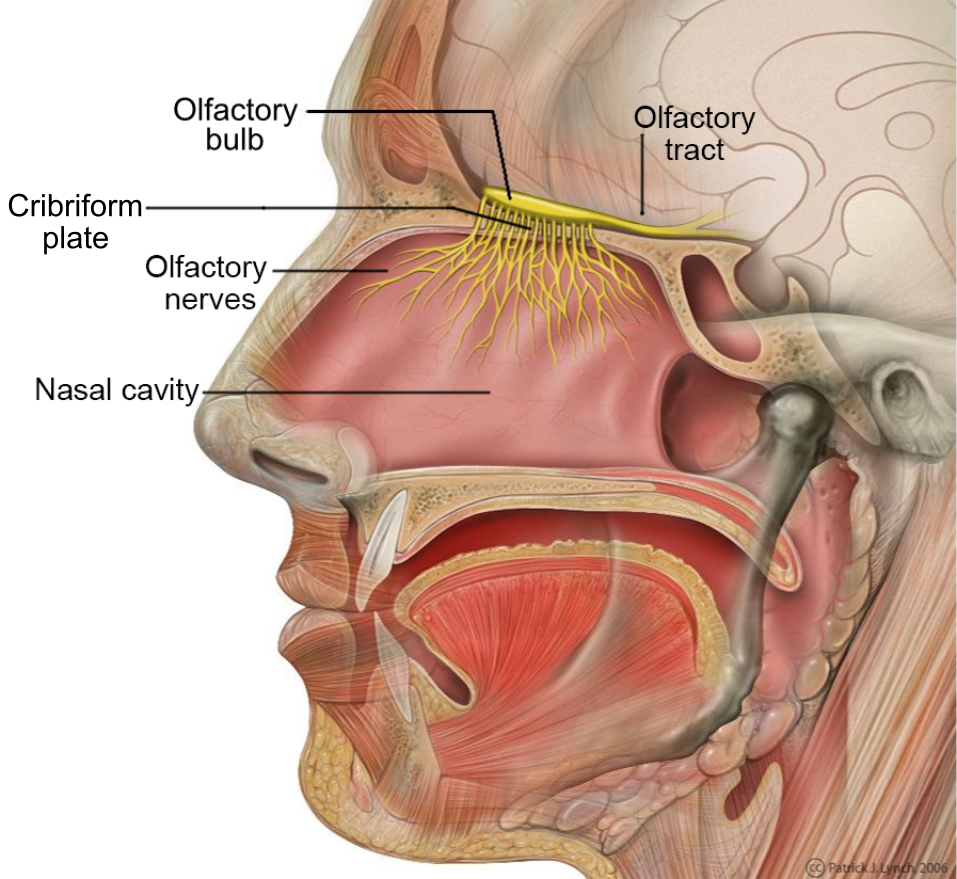
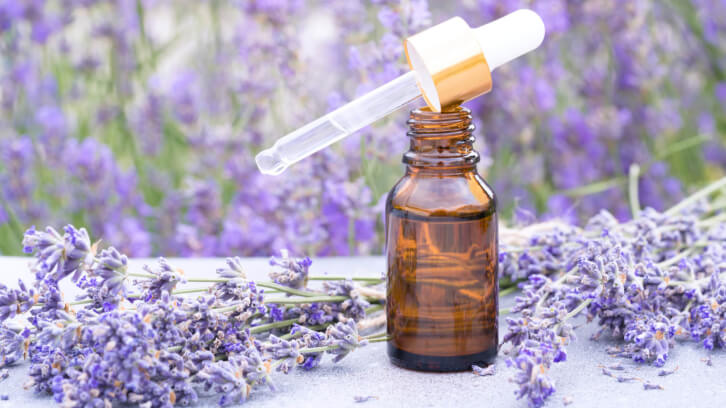
Scent refers to a pleasant odor, which is caused by volatile chemical compounds which humans and many animals can perceive via their sense of smell.
The SENSE of smell is usually regarded as rudimentary, showing its importance in survival mechanisms, such as the identification of predators, attraction of mating pairs, or location of food.
Interestingly, the neurological structure of the olfactory organ differs from other senses. Unlike the other sensory systems, which are routed via thalamus to the brain cortex (seat of the analytical mind), the olfactory tract is relayed directly to the limbic system, a brain region associated with memory and emotional processes. This is why the sense of smell possesses a unique ability to influence moods and social behaviors and contributes to memory creation.
Scent can be harnessed to induce emotional and physiological responses that can improve human health and well-being.
Odors that evoke positive personal memories have the potential to increase positive emotions, decrease negative mood states, and reduce physiological indices of stress, including systemic markers of inflammation. These relationships underlie e.g., the stress-releasing and mood-lifting effects possessed by some essential oils.
AROMATHERAPY is a complementary health practice, which uses aromatic plant extracts, mainly essential oils, for healing purposes. When inhaled, the scent molecules generate nerve signals, which travel from the olfactory organ directly to the emotional centers of the brain.
The effects of aromatherapy are still under scientific investigation; e.g., this method was described as effective for pain relief in labor, blood pressure reduction in hypertension, and reduction of stress, depression, sleep disorders, and anxiety.
ESSENTIAL OILS are aromatic, volatile liquids obtained from plants through steam distillation. Sometimes known as volatile oils or etheric oils, they contain the essence of the plant from which they are derived. Essential oils (EO) are obtained from different parts of the plants: e.g., from flowers (rose or lavender EO), leaves (eucalyptus), bark (cinnamon), wood (sandalwood), seeds (anise), peel (orange), rhizome (ginger), or resin (frankincense EO).
Essential oils make part of traditional medicine since ancient times. Avicenna, the preeminent physician of the Muslim world in the 11th century, was reportedly the first to derive the precious fragrance of flowers from distillation.
Author of the review: Kristina Höschlová
https://pubmed.ncbi.nlm.nih.gov/23573142/
https://pubmed.ncbi.nlm.nih.gov/21854199/
https://pubmed.ncbi.nlm.nih.gov/33224252/
https://pubmed.ncbi.nlm.nih.gov/12112282/
https://pubmed.ncbi.nlm.nih.gov/19249919/
https://pubmed.ncbi.nlm.nih.gov/22517298/
https://pubmed.ncbi.nlm.nih.gov/22558691/
https://pubmed.ncbi.nlm.nih.gov/28579958/
https://pubmed.ncbi.nlm.nih.gov/36309115/
https://pubmed.ncbi.nlm.nih.gov/23567808/
The healing power of nature
Forest Medicine (Shinrin Yoku)


Shinrin yoku (derived from the Japanese shinrin’yoku = “forest bathing“), sometimes referred to as nature therapy or forest therapy, is a salutary method, which consists of spending time in nature with awareness in order to relieve stress, reestablish inner harmony and improve mental and physical health. Various physiological benefits have been proven by numerous studies, e.g., improved immunity function, balanced cardiovascular system, better sleep and decrease in depression and anxiety.
In the 16th century, the famous Swiss physician and philosopher Paracelsus wrote: „The art of healing comes from nature, not from the physician.“
The term shinrin-yoku was defined in 1982 by the head of the Japanese Ministry of Agriculture, Forestry, and Fisheries, Tomohide Akiyama, to encourage more visitors to forests.
Nowadays, shinrin yoku makes up an inseparable part of the non-invasive and non-pharmacological medicinal approach, mainly in Japan.
Health benefits of forest therapy are above all demonstrated by the immune system and are attributed to volatile substances emanated from the trees. Phytoncides (e.g., alfa-pinene or limonene) are wood essential oils and besides their antibacterial properties, they help regulate the autonomic nervous system.
In one study, twelve subjects were tested before and after a three-day sojourn in a forest. The outcome showed that activity and number of the NK cells (NK – “natural killer”) increased by more than 50% after the forest-bathing. NK cells present a powerful immunity tool eliminating virus-infected- and tumor-cells. Therefore, increase in their number and activity is associated with an important immunity reinforcement.
Another study observed 12 subjects undertaking sessions in 24 different Japanese forests. Activity of the subjects’ physiological functions and stress-hormone levels were compared to that measured after interrelated sessions in the city environment. Results associated with the time that subjects spent in the forest environs displayed remarkable decreases in adrenaline, noradrenaline and cortisol levels, as well as in the blood pressure and heart rate. This refers to a shift from the sympathetic to the parasympathetic activity of the autonomic nervous system meaning the establishment of the relaxing state.
It is not surprising that forest environments provide salutary effects also on mental health. In 500 subjects, a one day sojourn in nature led to increased emotions of friendliness and wellbeing and decreased negative emotions including hostility and depression, compared to control evaluations.
Although health benefits of the forest are mostly attributed to chemical substances produced by trees, there is probably much more beyond this simple hypothesis.
Plants are living organisms subject to the same rules of Life on Earth as human beings. Like all living organisms, plants use deoxyribonucleic acid (DNA) as their genetic material and they emanate electrochemical potentials which can contribute to their interactions with other living forms.
Whatever the mechanism of the healing effect of nature is, it is highly advisable to benefit from its presence, especially in times of weak immunity or during stressful life-periods.
Author of the review: Kristina Höschlová
HEALING POWER OF THE EARTH
EARTHING, Barefoot Walking



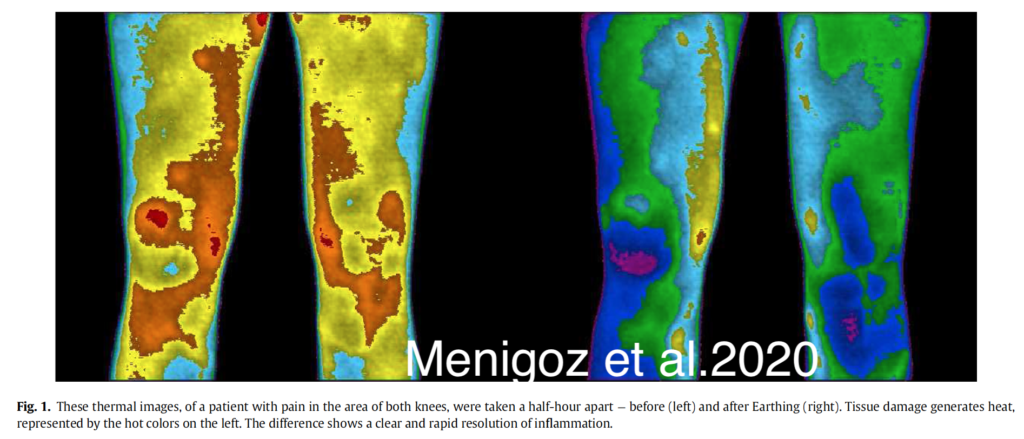


EARTHING is a complementary healing technique that allows the free electrons on the Earth surface to work as antioxidative agents reducing different pathological conditions in the human body.
The Earth’s atmosphere is subject to a continual and substantial electrical current, which varies according to a daily pattern, shows seasonal variation, and creates a “Global electrical circuit”.
Earth is electrically neutral, but the interior of Earth is positively charged, whereas the crust is negatively charged. The surface of the Earth possesses a continuously renewed supply of free electrons as a consequence of a global atmospheric electrical circuit.
EARTHING (also known as grounding) refers to the discovery that bodily contact with the Earth’s natural electric charge stabilizes physiology at the deepest levels, reduces inflammation, pain and stress, improves blood flow, energy and sleep, and generates greater well-being.
One of the most powerful effects of Earthing, as documented over nearly 20 years of research, along with feedback from thousands of individuals around the world, is reduction of chronic inflammation, a common cause or aggravating factor for chronic and aging-related diseases, as well as pain. (Menigoz 2020)
The EARTHING PRACTICES are very simple: e.g., barefoot walking, relaxing on the beach or in a meadow, swimming in the natural waters, or sleeping on the ground in the open.
The most reasonable hypothesis to explain the beneficial effects of Earthing is that a direct earth connection enables free electrons to flow from the Earth to the body. It is suggested that free electrons from the Earth’s surface act as antioxidants neutralizing the positively charged free radicals that are the hallmark of chronic inflammation. (Oschman 2007)
An antioxidant is a molecule donating an electron to a free radical and neutralizing it, thus reducing its capacity to damage cells and tissues.
Connection to the global electrical circuit has an important impact also on the hormone systems related to circadian rhythms.
One hundred test subjects who lived for a month in an underground bunker, completely removed from exposure to natural daylight, were able to maintain an internal synchronization to a day/night rhythm, even with the complete absence of sunlight. But when the same subjects were additionally shielded from the global electronic circuit of the Earth, it resulted in internal desynchronization of the circadian body rhythm. However, when these subjects were consequently exposed to the Schumann resonance frequencies (activity of the Earth’s electromagnetic field), their day/night rhythm became re-synchronized once again. (Koniver 2023)
The Schumann resonances are a set of spectrum peaks of the Earth’s electromagnetic field. They are created in the resonant cavity formed between the Earth and ionosphere, excited by lightening; they exist worldwide at 7,83 Hz along with harmonics of that frequency.
EARTH as a REMEDY for PAIN and INFLAMMATION
Various studies have provided evidence of Earthing’s impact on inflammation and pain. One of the methods to assess the process of inflammation is thermal imaging that register small changes in skin temperature.
E.g., thermal pictures of a patient with pain in the area of both knees were taken a half-hour apart − before and after Earthing. Tissue damage generates heat, represented by the hot red-shaded colors on the left. The difference shows a clear and rapid resolution of inflammation after Earthing (please, see the picture on the left).
Another study conducted at the University of Salzburg showed specifically that Earthing during sleep produces faster recovery and/or less pronounced markers of muscle damage and inflammation when compared to without Earthing. (Menigoz 2020)
BAREFOOT WALKING
A part from the assumed impact on the immune and other regulation systems, barefoot walking shows its benefits also in the prevention of injuries of the lower-extremities.
Barefoot walking changes the biomechanical parameters of the gait and body posture resulting in reduced step length and increased step cadence, lower plantar pressure and ground reaction force, increased sensory feedback from the ground-foot contact and changes in the physiology, such as wider feet.
Barefoot walking in the dewy grass was one of the typical recommendations of the famous naturopath Sebastian Kneipp. He often advised patients to walk barefoot outdoors in nature, preferably in moistened conditions. The contribution of water while barefoot walking (e.g., on the beach or after a rain) should increase electrical conductivity which permits more effective grounding. For more about Kneipp’s hydrotherapy, please check the “Hardening section” in our Applied techniques list.
Author of the review: Kristina Höschlová
Earthing:
https://www.ncbi.nlm.nih.gov/pmc/articles/PMC3265077/
https://pubmed.ncbi.nlm.nih.gov/31831261/
https://pubmed.ncbi.nlm.nih.gov/36481428/
https://pubmed.ncbi.nlm.nih.gov/36496151/
https://pubmed.ncbi.nlm.nih.gov/36336303/
https://pubmed.ncbi.nlm.nih.gov/25435837/
https://pubmed.ncbi.nlm.nih.gov/33762998/
https://pubmed.ncbi.nlm.nih.gov/36528336/
https://pubmed.ncbi.nlm.nih.gov/36773844/
https://pubmed.ncbi.nlm.nih.gov/21469913/
https://pubmed.ncbi.nlm.nih.gov/8862535/
https://pubmed.ncbi.nlm.nih.gov/18047442/
Barefoot walking
https://pubmed.ncbi.nlm.nih.gov/26220400/
https://pubmed.ncbi.nlm.nih.gov/31166116/
https://pubmed.ncbi.nlm.nih.gov/22965347/
https://pubmed.ncbi.nlm.nih.gov/22580495/
https://pubmed.ncbi.nlm.nih.gov/31166116/
https://pubmed.ncbi.nlm.nih.gov/26744483/
GET INSPIRED, LEARN MORE
Recommended books

If interested in the topics of non-pharmacological interventions and complementary medicine, you would surely enjoy some of the following titles:
- Joe Dispenza: You Are the Placebo: Making Your Mind Matter
- David R. Hawkins: Healing and Recovery
- James Nestor: Breath: The New Science of a Lost Art
- Gregory Ninot: Non-Pharmacological Interventions: An Essential Answer to Current Demographic, Health, and Environmental Transitions
- Martin Seligman: Authentic Happiness
- Mimi Kuo-Deemer: Xiu Yang: The Ancient Chinese Art of Self-Cultivation for a Healthier, Happier, More Balanced Life
- Thomas R.Verny: The Embodied Mind: Understanding the Mysteries of Cellular Memory, Consciousness, and Our Bodies


